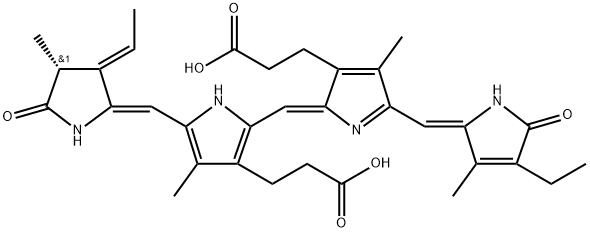
Phycocyanobilin is an effective scavenger for various reactive oxygen species. Phycocyanobilin can be used for the research of Alzheimer’s disease. Its cell-protective mechanisms include the reduction of oxidative stress damage, which may contribute to its efficacy in the study of neurodegenerative diseases.
| Molecular Weight | 586.69 |
| Formula | C33H38N4O6 |
| CAS Number | 20298-86-6 |
| Solubility (25°C) | Soluble in Water/PBS after breaking the cell wall using ultrasonic cell disruptor |
| Storage | -20°C, protect from light, sealed |
| Species | Mouse | Rat | Rabbit | Guinea pig | Hamster | Dog |
| Weight (kg) | 0.02 | 0.15 | 1.8 | 0.4 | 0.08 | 10 |
| Body Surface Area (m2) | 0.007 | 0.025 | 0.15 | 0.05 | 0.02 | 0.5 |
| Km factor | 3 | 6 | 12 | 8 | 5 | 20 |
| Animal A (mg/kg) = Animal B (mg/kg) multiplied by | Animal B Km |
| Animal A Km |
For example, to modify the dose of Compound A used for a mouse (20 mg/kg) to a dose based on the BSA for a rat, multiply 20 mg/kg by the Km factor for a mouse and then divide by the Km factor for a rat. This calculation results in a rat equivalent dose for Compound A of 10 mg/kg.
[1] Runze Liu, et al. Biomed Pharmacother. Phycocyanin: Anti-inflammatory effect and mechanism
[3] Yi Li. J Immunol Res. The Bioactivities of Phycocyanobilin from Spirulina
| Related ROS Products |
|---|
| Dihydroferulic acid
Dihydroferulic acid (Hydroferulic acid) is one of the main metabolites of curcumin and antioxidant/radical-scavenging properties with an IC50 value of 19.5 μM. Dihydroferulic acid (Hydroferulic acid) is a metabolite of human gut microflora as well as a precursor of vanillic acid. |
| Arg-Tyr
Arg-Tyr is a dipeptide which has strong hydroxyl-radical and hydrogen-peroxide scavenging activity. |
| HNGF6A
HNGF6A is a humanin analogue. |
| Glutathione ethyl ester
Glutathione ethyl ester is a cell-permeable GSH donor and provides an efficient supply of GSH to the oocyte. |
| Palmitoyl tripeptide-38
Palmitoyl tripeptide-38 is a bioactive peptide with anti-aging effect . |


Products are for research use only. Not for human use. We do not sell to patients.
© Copyright 2010-2023 AbMole BioScience. All Rights Reserved.
